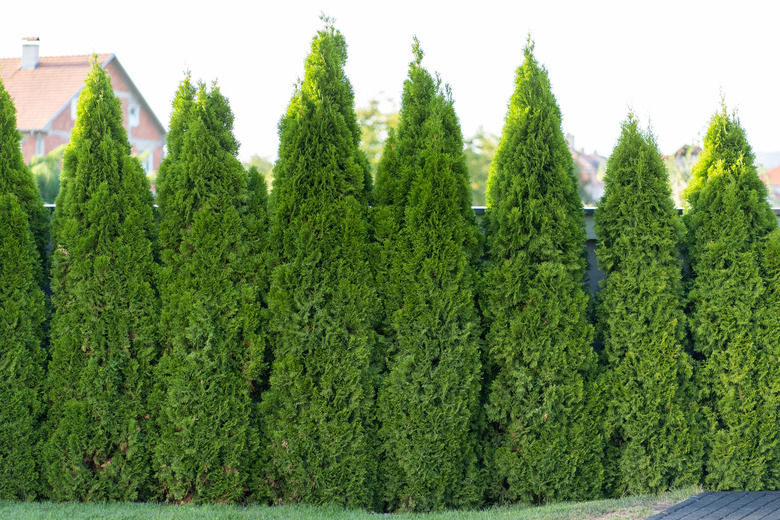Arborvitae Green Giant Vs. Thuja Green Giant
Fast-growing evergreen Thuja standishii x plicata 'Green Giant' is often promoted as the ideal tree for impatient gardeners. While different suppliers may refer to this tree as arborvitae 'Green Giant' or Thuja 'Green Giant,' they are the same species. This tall, narrow tree makes an excellent privacy screen or specimen planting. It grows 1 to 3 feet per year once established.
Origins of Green Giant
According to the U.S. National Arboretum in Washington, D.C., Danish nurseryman D.T. Poulsen was responsible for bringing the first specimen to the arboretum in 1967. Researchers planted this tree and noted its fast growth rate and other exceptional qualities. Confusion over the name developed once the arboretum began distributing clones that it had propagated. After extensive analysis and research, representatives from the U.S. National Arboretum, New York Botanic Gardens and Holden Arboretum selected the name Thuja Green Giant to identify this clone. DNA testing during this process showed the tree to be a hybrid of Thuja standishii (Japanese arborvitae) and T. plicata (western red cedar).
Characteristics of Green Giant
Green Giant has a symmetrical, conical shape. Unlike other arborvitaes, the dense foliage darkens only slightly in the winter. The tree can also withstand winter snow and ice loads on its branches. It performs best in moist, well-drained soil and sun or partial shade. Green Giant can easily grow 3 feet a year in good conditions, ultimately reaching a height of 50 to 60 feet. A mature specimen will be about 10 to 20 feet wide, but a row of Green Giant trees can be planted just six feet apart for a quick screen. In fact, a row of 3-foot-tall Green Giants planted at the U.S. National Arboretum in 1998 was 20 feet tall just 10 years later. Hardy in U.S. Department of Agriculture zones 5 through 7, Green Giant produces small pine cones that start out green and gradually turn to brown.
Using Green Giant in the Landscape
The Green Giant arborvitae received the prestigious Pennsylvania Horticultural Society Gold Medal Plant Award in 1998. Today, this tree remains valuable in the home landscape because it offers excellent disease and pest resistance. Green Giant also requires very little maintenance and it's somewhat drought tolerant. Rural or suburban homeowners who have issues with deer will find that the animals do not typically graze on the foliage. In addition, it makes an ideal replacement for the disease-prone Leyland cypress. Homeowners may choose to use this tree in different ways. Single specimen trees have a majestic appearance. Several trees spaced along the back of a lot can provide privacy and absorb road noise. Trees planted closely together can even be pruned into a hedge.
Propagating Green Giant
Green Giant can be propagated by anyone since it is in the public domain. New trees are easily rooted from cuttings. Although the nursery industry is heading toward a model where many plants are patented and propagation is closely monitored, Green Giant is readily available. Homeowners can find it at home improvement stores, wholesale suppliers, nurseries and mail-order catalogs.
